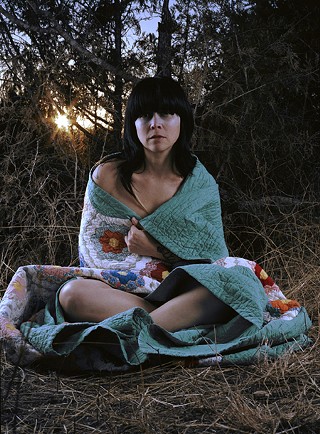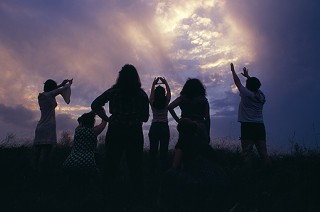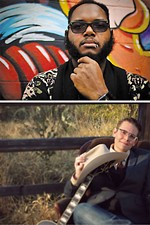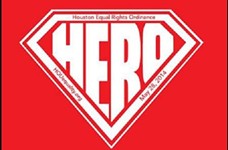Heads in the Sky; Feet on the Ground
Leah DeVun's very intentional exploration of lesbian space
By Andy Campbell, Fri., June 4, 2010
Austin Chronicle: Where does the title of your show, "Our Hands on Each Other," come from?
Leah DeVun: It comes from this really amazing book called Lesbian Land, which came out in the 1980s – a compilation of writings and interviews about womyn's lands, women's intentional communities, and land dykes. There's a quotation on the back cover – "Our heads in the sky, our feet on the ground, and our hands on each other" – and I just love that. Someone else pointed out that the title has the same kind of feeling that Our Bodies, Ourselves has to it. The titles to all these lesbian magazines I'm working with are so poetic. So some of the photographs in the show are titled after the magazines because I think the language is so powerful. And these magazines are so eclectic: They have poetry; they have songs; they have photographs and drawings. They're thinking about themselves on all these different levels and putting it all together in a way that crosses boundaries in a way that you don't see so much right now. I mean, people are really compartmentalized. People ask me: "What are you? Are you a photographer? Are you a sculptor?" I think the fluidity in the kinds of source material I'm using is not as common as it once was.
AC: Describe the exhibition as it will exist at Women & Their Work.
LD: It is truly inspired by that eclecticism. The show is based in photography, but it does draw from multiple formats to capture the spirit of those magazines. The exhibition consists of eight color photographs, three light boxes, archival material, and a built structure. The light boxes are intended to capture that zine/photocopied imagery and energy. When I think of grassroots political activism, I think of photocopies! But then I also feel that much of the show, especially the photographs, is very quiet and contemplative – getting at community but also aloneness and the body in nature. I'm trying to get at the movement in both senses of the word: the Movement, but also the physical movement. The light boxes are all based on original photographs, but then they also connect to the group of archival materials that we're going to have on-site – a number of magazines and journals from the 1970s and 1980s, which I used to title some of the photographs. In this case I want my work to be more obvious than usual, because when people come to see the show, I want them to connect with it on an aesthetic level, but I also want them to become aware of the actual materials that inspired the show. I want to suggest this history that is pretty uncovered for people of our generation, even if they're really well-versed in queer/feminist political issues. I'm really surprised by how many people have been totally unaware of that history of womyn's lands, the magazines, and that network of women and men. I should also mention that there will be a structure – we've been calling it "the lesbian shack" – that is in the spirit of the buildings I saw on the womyn's land I visited. The structure is unfinished, and I want to invite people to add some pieces to it, because I like shows where you can do something. Who doesn't want to bang on something in a gallery?! For me it's about space: How do we come together to make something? I'm interested in the gestures people make and the way my vision will be altered.
AC: In the exhibition you use archival material from lesbian separatist or intentional womyn's communities alongside photographs of Austin queers. Is this to intentionally draw a line between the two moments?
LD: I definitely wanted to ask questions about how we define "women" or "feminism" now, and those are questions that were definitely debated in the 1970s and 1980s. Who is allowed to be involved in these kinds of projects? Who identifies whom? Who is able to self-identify as a woman or as a feminist? How are these kinds of identities contested or policed? All of those things. So not all the people in the photographs identify as lesbians, but they somehow identify somewhere in that spectrum. Although let me say that some of the lesbians I met with, who were some of the builders of those magazines, are still totally aware of these conversations. It's something they're still thinking about. I'm not saying I'm coming up with something new here, but I definitely want to be in dialogue with those issues that have a real political importance.
AC: That's what's amazing to me. You're coming at these intentional communities not as static, stuck-in-the-1970s relics, but as communities that are still out there. One of the things I notice is that people elide so easily feminism, lesbianism, lesbian separatism, radical lesbianism, all these different kinds/branches/forms of feminism. What do you hope this project does for those who see feminism, even lesbianism, as only one kind of thing?
LD: I'm definitely interested in addressing the relationship of lesbian separatism and lesbian activism with feminism in the 1970s. I mean, that's the reason I have one of the models wearing a "Lavender Menace" T-shirt. Questions about how lesbianism fits in with the feminist movement were and still are uneasy. I was reading an autobiography by Susan Brownmiller, and clearly these types of criticism still haunt the feminists that were leaders at the time, that were heterosexual. On the one hand, there's a conflation about lesbianism and feminism, but at the time that conflation was not so easy. It was something people were trying to work out, and the tensions between straight feminists and lesbian feminists were a big part of the movement. I hope this project does a lot of things. Some of these people who created these spaces, founded intentional communities, who took part in creating art, language, and publications are really the unsung heroes of queer feminist movements. They're pretty much unacknowledged. My interest as a historian ... I have a very straightforward interest in reclaiming and publicizing that history. Another thing I'm interested in doing is creating a dialogue between young feminists and lesbians and ones of a previous generation. Some of the women who were out on the womyn's lands were very forthright in saying that because they had separated themselves out into these communities that they felt were outside of society, they disconnected themselves from people who were not a part of their community. People of the next generation coming up don't necessarily learn about the history and the skills and the entire lifestyle of people who were creating those communities at the time. By interviewing people in Austin who were part of the movement, I've connected with a bunch of people who are in their 50s and 60s, and I hope some of them are going to come to the show. As a young lesbian, I hardly ever meet lesbians who are in their 60s, I don't even see pictures of lesbians in their 60s. How can we create bridges that are not only about people's pasts and people's futures? Lastly, I want to create a situation in which people who are artgoers, who may not think about queer history and space, have to reckon with the ways that queers and feminists created some institutions in Austin and beyond.
AC: I'm interested in your dual role as history professor (at Texas A&M) and as artist. Can you discuss those intersections?
LD: Well, my background as a historian who is interested in issues surrounding the body, gender, and technology draws me to a process that is based in research, archives, interviews, and oral histories. So this project has been a nice fusion of different kinds of practices that are actually a part of my academic career. Sometimes people view scholarship and artistic practice as two separate pathways, and this show has been a means of bringing together those different sets of skills.
AC: Have you worked or written about womyn's lands before?
LD: I haven't written about that, but I have written on contemporary rural gay communities. I think people are starting to become interested in that, because for a long time history only focused on what seems to be the "natural" migration of gay people. What happens when you find out you're gay and you're from a small town – well, you go to San Francisco! And there are articles written about this, "Get Thee to a Big City" by Kath Weston being one example. I think public reaction to really tragic gay-bashing incidents has been, "Well, what was that person doing in rural Nebraska?" I think the tide is turning against that attitude, and people are starting to look at the gay culture that might be centered in rural communities that are just as vibrant and important as urban gay communities. And it doesn't mean that it's just a sad version of gay life in the big city.
AC: There are many artists who work on already-historicized communities and moments and yet are emphatic about the work not being about the past. I'm thinking of an artist like Kara Walker, who uses 19th century modes of production (the silhouette) and whose figures seem to be so placed in the antebellum South but is adamant that the work is about the present. Do you find this to be the case with your work as well?
LD: I think this show is plugging into a moment where some people are retreating from a more modern and convenient lifestyle to connect with primal yet sustainable spaces. These kinds of shows are always about now. Whenever you're doing history, you can't always separate the kinds of history you are getting interested in from your current moment. So of course, I'm interested in "How can we create our communities? Who fits into lesbian identity?" I think these questions of identity politics have been important all along but are certainly conversations I'm hearing right now – especially as they relate to trans-identity. You know, when I was talking to some of the politically engaged queers I know about these women on womyn's lands, they didn't understand why these women separated themselves out from society and didn't work from within to change society. And I posed that question to a woman who lives in one of these intentional communities, and she told me, "Some people are reformers, they want to work within the system, and there's nothing wrong with that, but some people are revolutionaries," and that's not a conversation I hear right now. Many of these women have expressed opinions that have fallen away from larger discussions about feminism and queer politics. And not that I agree with every single thing I hear, but it was eye-opening and incredibly stimulating.
The opening of Leah DeVun's "Our Hands on Each Other" exhibit is tonight (Thursday) and runs through July 15 at Women & Their Work, 1710 Lavaca, 477-1064. www.leahdevun.com.










